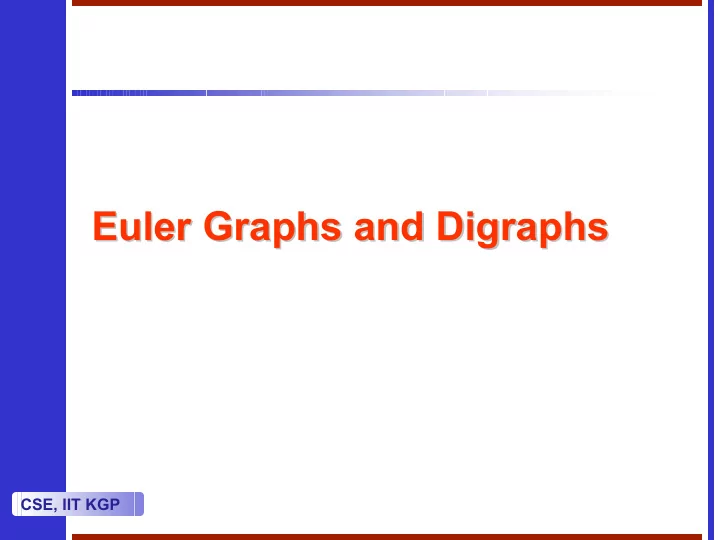

Euler Graphs and Digraphs Graphs and Digraphs Euler CSE, IIT KGP
Euler Circuit Circuit Euler • We use the term We use the term circuit circuit as another name for as another name for • closed trail . . closed trail – A circuit containing every edge of G is an A circuit containing every edge of G is an – Eulerian circuit. circuit. Eulerian – A graph whose edges comprise a single closed A graph whose edges comprise a single closed – trail is Eulerian Eulerian. . trail is CSE, IIT KGP
Properties Properties • Non- -trivial maximal trails in even graphs are closed. trivial maximal trails in even graphs are closed. • Non • A finite graph G is Eulerian Eulerian if and only if all its vertex if and only if all its vertex • A finite graph G is degrees are even and all its edges belong to a single degrees are even and all its edges belong to a single component. component. • For a connected nontrivial graph with 2k 2k odd vertices, odd vertices, • For a connected nontrivial graph with the minimum number of pairwise pairwise edge edge- -disjoint trails disjoint trails the minimum number of covering the edges is max{k, 1}. max{k, 1}. covering the edges is CSE, IIT KGP
Fleury’s Algorithm Algorithm Fleury’s Input: A graph G with one non A graph G with one non- -trivial component and trivial component and Input: at most two odd vertices. at most two odd vertices. Initialization: Start at a vertex that has odd degree Start at a vertex that has odd degree Initialization: unless G is even, in which case start at any vertex. unless G is even, in which case start at any vertex. Iteration: From the current vertex, traverse any From the current vertex, traverse any Iteration: remaining edge whose deletion from the graph remaining edge whose deletion from the graph does not leave a graph with two non- -trivial trivial does not leave a graph with two non components. Stop when all edges have been components. Stop when all edges have been traversed. traversed. CSE, IIT KGP
Euler Trails in Directed Graphs Trails in Directed Graphs Euler Input: A digraph G that is an orientation of a connected graph Input: A digraph G that is an orientation of a connected graph ∈ V(G) − (u) for all u ∈ and has d + (u) = d − (u) for all u V(G) . . and has d + (u) = d ∈ V(G) ′ be the digraph v ∈ . Let G ′ Step1: Choose a vertex Choose a vertex v V(G) . Let G be the digraph Step1: obtained from G by reversing direction on each edge. obtained from G by reversing direction on each edge. Search G ′ ′ to construct T to construct T ′ ′ consisting of paths from Search G consisting of paths from v v to all to all other vertices. other vertices. ′ . T contains a Let T be the reversal of T ′ Step2: Let T be the reversal of T . T contains a u,v u,v- - path in G for path in G for Step2: u ∈ ∈ V(G) each u each V(G) . Specify an arbitrary ordering of the edges . Specify an arbitrary ordering of the edges ≠ v, u ≠ that leave each vertex u, u, except that for except that for u v, the edge the edge that leave each vertex leaving u leaving u in T must come last. in T must come last. Step3: Construct an Step3: Construct an Eulerian Eulerian circuit from circuit from v v as follows. as follows. Whenever u u is the current vertex, exit along the next is the current vertex, exit along the next Whenever unused edge in the ordering specified for edges leaving u. u. unused edge in the ordering specified for edges leaving CSE, IIT KGP
The Chinese Postman Problem The Chinese Postman Problem • Suppose a mail carrier traverses all edges Suppose a mail carrier traverses all edges • in a road network, starting and ending at in a road network, starting and ending at the same vertex. the same vertex. – The edges have non The edges have non- -negative weights negative weights – representing distance or time. representing distance or time. – We seek a closed walk of minimum total length We seek a closed walk of minimum total length – that uses all the edges. that uses all the edges. CSE, IIT KGP
Recommend
More recommend